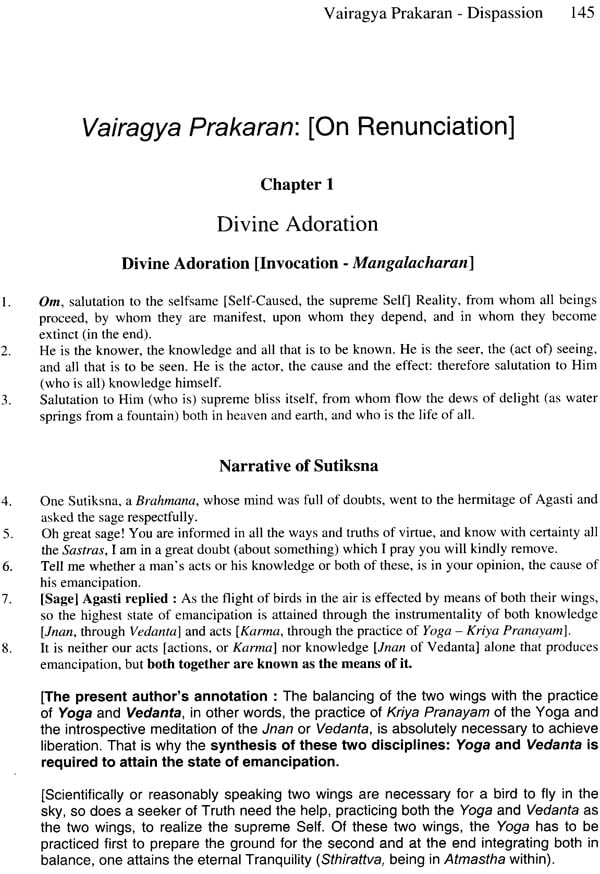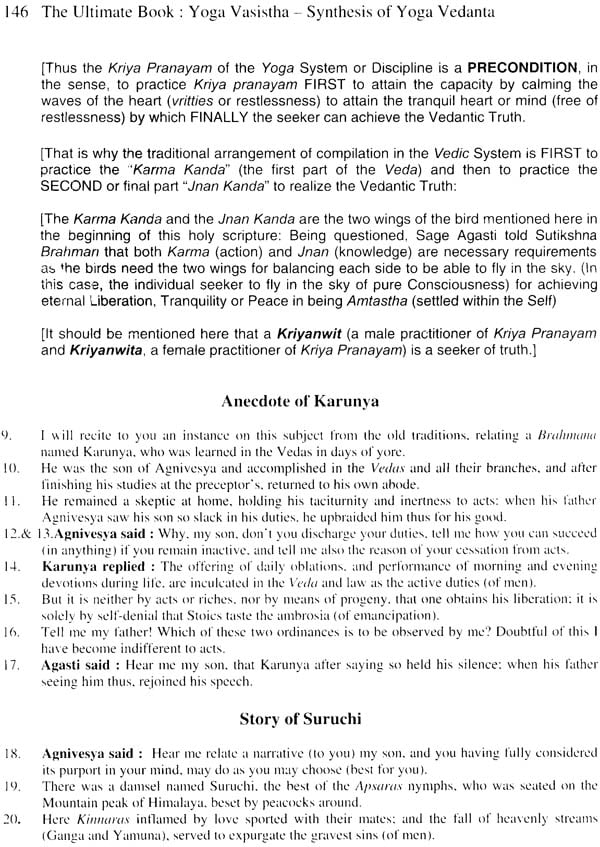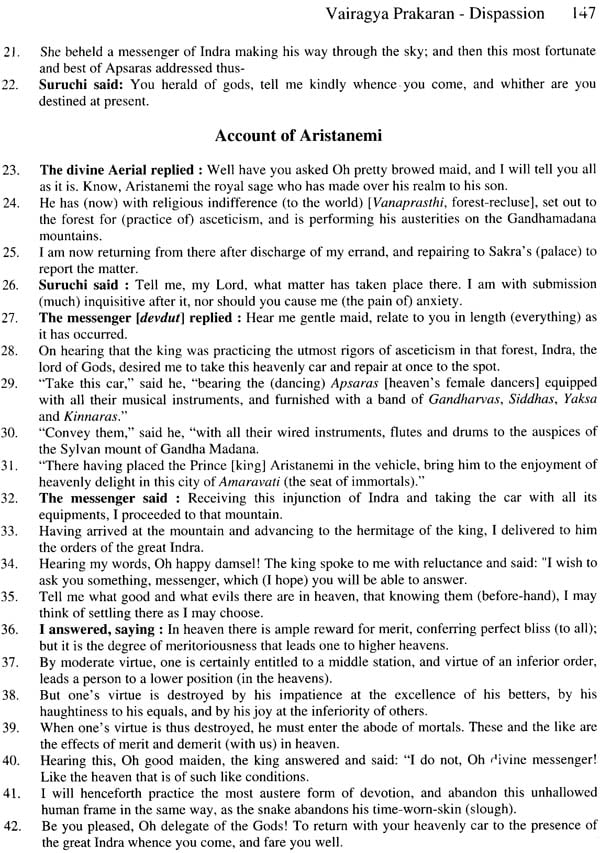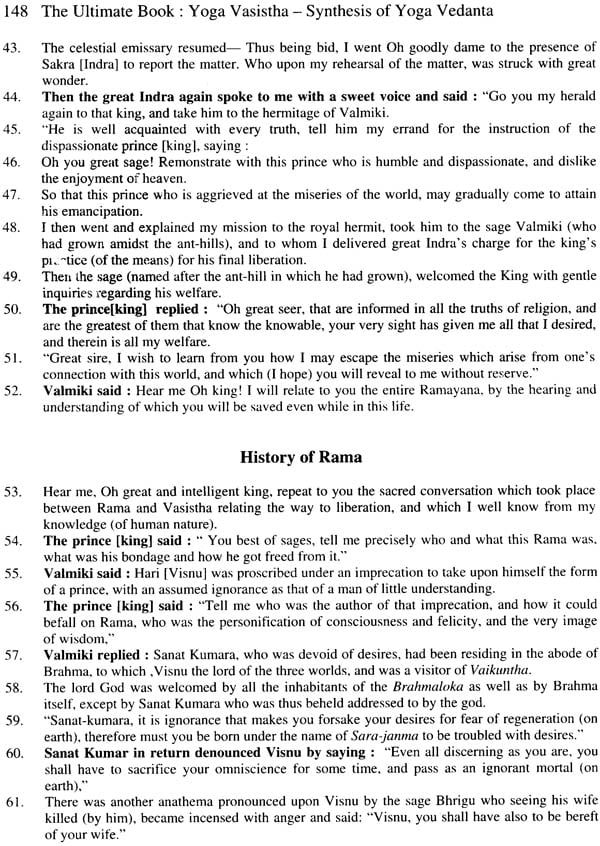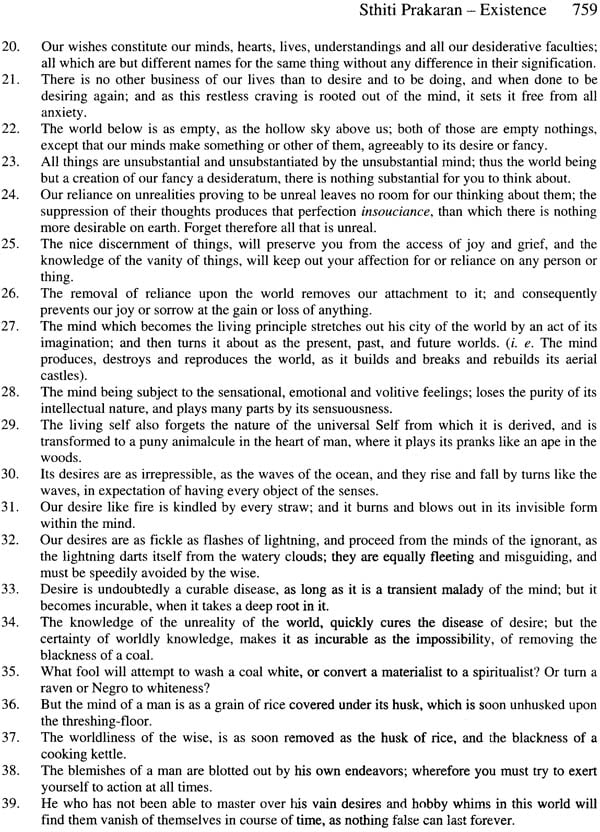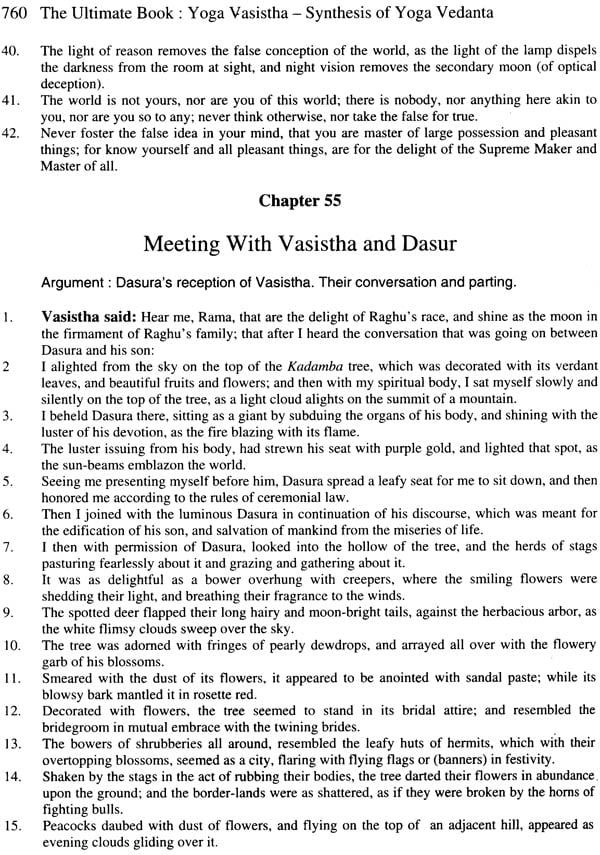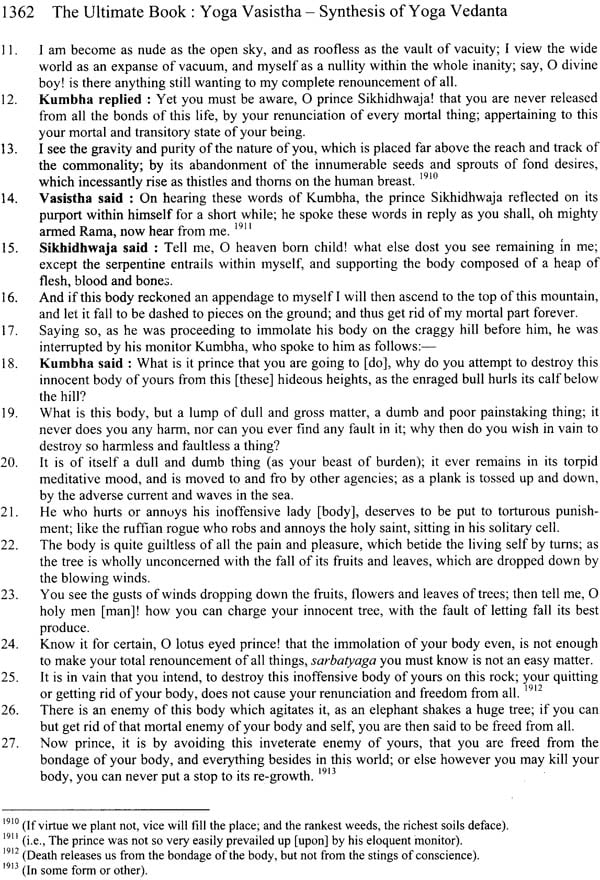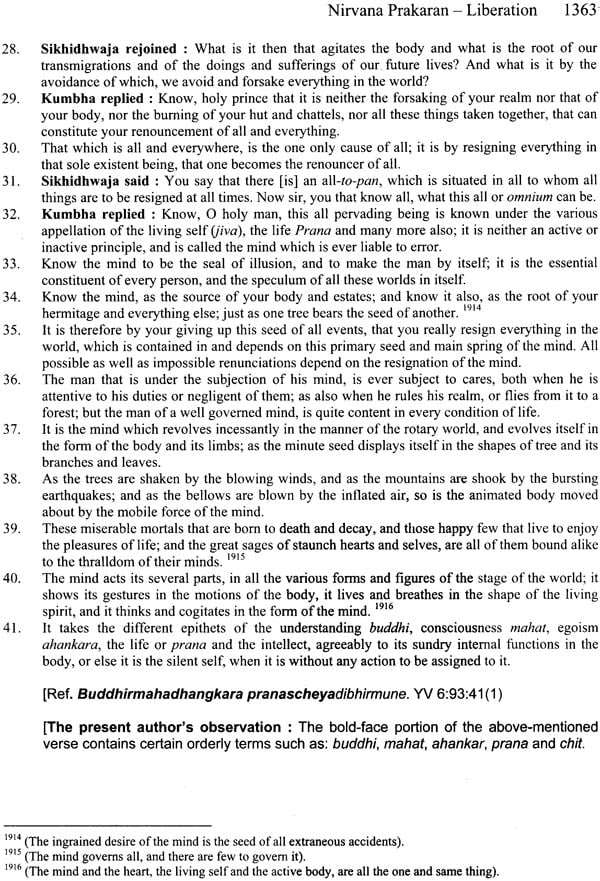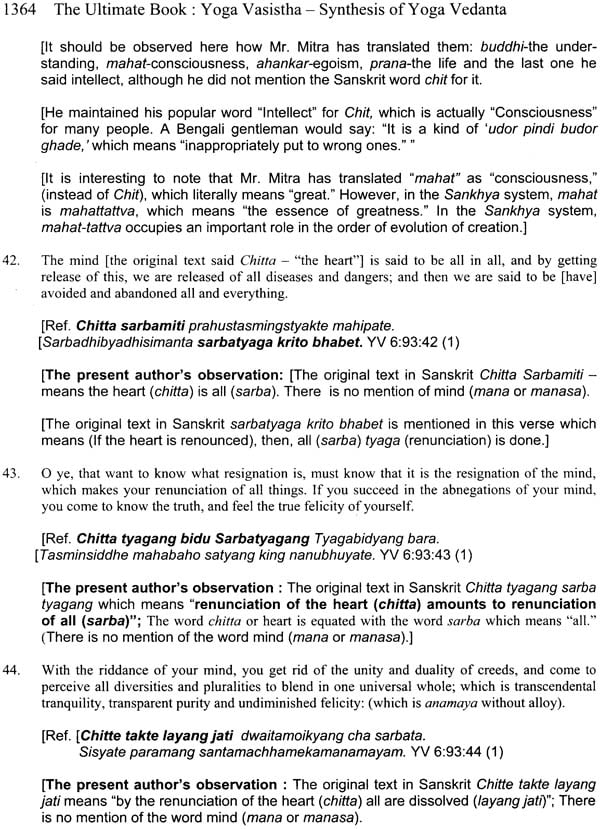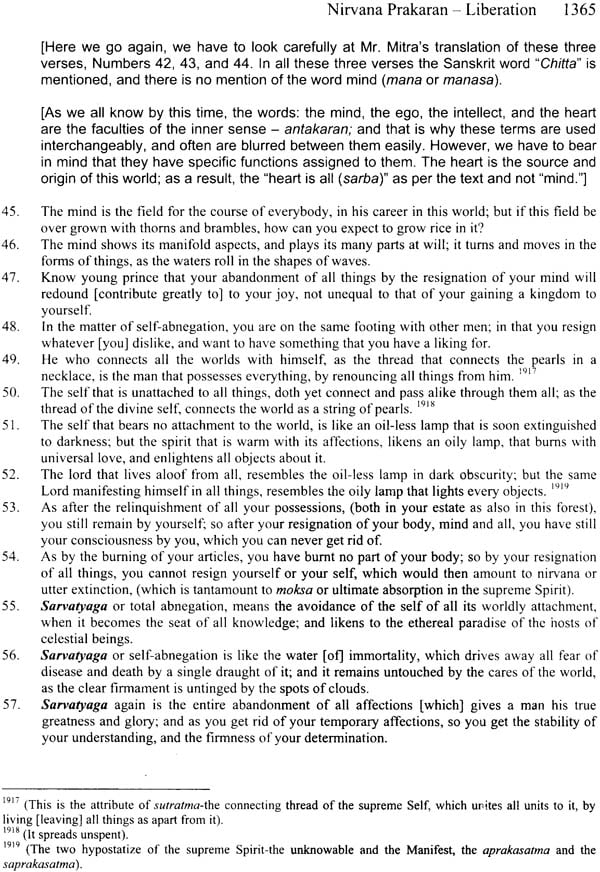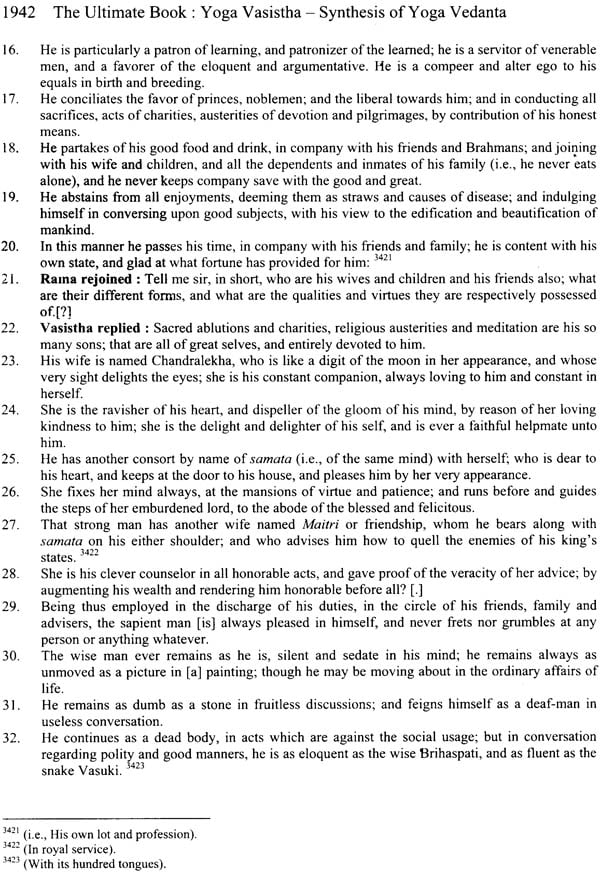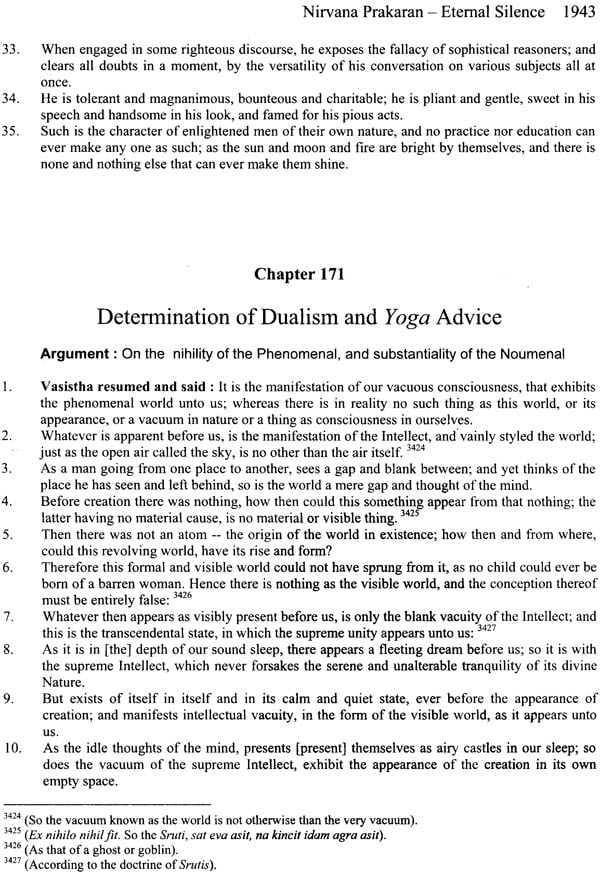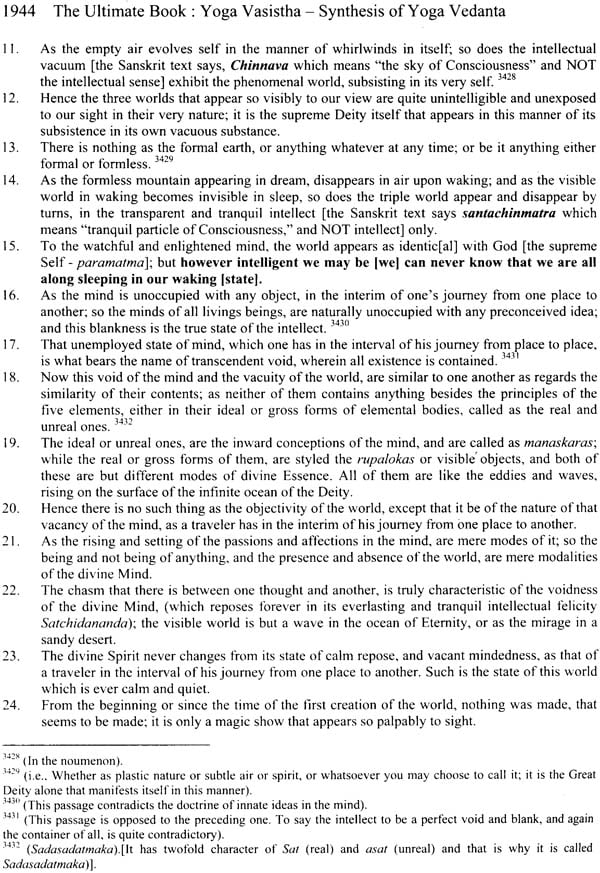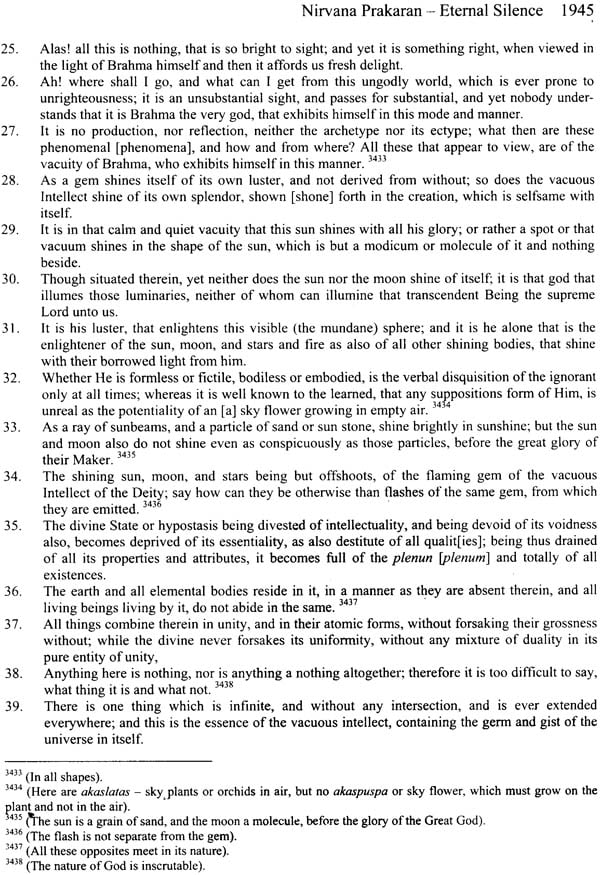
The Ultimate Book (Yoga Vasistha- Synthesis of Yoga Vedanta)(Set of 2 Volumes)
Book Specification
| Item Code: | NAE812 |
| Author: | Vihari Lal Mitra |
| Publisher: | The Sanskrit Classics |
| Language: | English |
| Edition: | 2011 |
| ISBN: | 9781877854507 |
| Pages: | 2111 (21 Color and 50 B/W Illustrations) |
| Cover: | Hardcover |
| Other Details | 11.0 inch X 9.0 Inch |
| Weight | 4.40 kg |
Book Description
The ultimate criteria of the test of Truth has to be eternal Existence and the all encompassing whole.
In fact, Atma, the Self, is the only self-evident Truth; there is nothing that can be more evident than the Self; neither God nor Brahma, nor any other highest Being mentioned in any religious faiths of the world. One can deny all of them expect the Self.
If for argument’s sake a skeptic or a non-believer denies the eternal Existence of the Self, the denier still exists: to deny the first denier needs a second and ad infinitum; and thus ultimately the last denier will exist and that is the Self. Thus the act of denying the existence of the Self is suicidal.
In this context, where is the scope of the seeker’s particular aspiration to achieve (Moksa)? The seeker’s aspiration starting from the very beginning with the erroneous conception or conviction of achieving something with desire (vasana) is the real obstruction which needs to be completely renounced. In reality, the seeker needs to be settled in Oneness with the Self (be Atmastha); and it can be done by tranquilizing the breath with the practice of Kriya Pranayam; only thereby, he will gain eternal Tranquility (Sthirattva) and Peace and Contentment (Santos).
Therefore, nothing else but realizing the Self is called Spirituality, attaining the absolute Knowledge of the Self (Atmajnan).
Yoga Vasistha Ramayan is a unique and very influential scripture of the Vedic culture. It deals with Adwaita Vedanta Philosophy of the ancient Vedic culture. In spite its uniqueness, this Holy Scripture was not widely recognized for the following reasons:
1. Yoga Vasistha Ramayan does not deal with the regular Ramayan of Valmiki which primarily describes the Character of Rama, the seventh Incarnation of Lord Visnu.
2. Yoga Vasistha deals with Adwaita Vedanta Philosophy, a specific Indian spiritual discipline out of six major disciplines (Sara Darsan).
3. It requires high and lofty preparations to practice the Adwaita Vedamta Discipline.
4. The householders do not find it easy to practice this discipline.
5. Besides, some renunciates who are not well prepared and qualified to follow the renunciate life and being tempted to achieve liberation quickly, prematurely have entered the renunciate orders; later they found it difficult and could not go back to regular life style; then wandering here and there for a while, began to tell the country side villagers that the household life style is the cause of suffering in life. They blame the household life. These so called renunciates propagate that Yoga Vasistha Ramayan deals with Adwaita Vedanta, which is not suitable for householders to practice. According to them, one has to renounce the household lifestyle and to enter into a renunciate lifestyle to qualify to practice the Vedanta way of life.
It is not true; it has never been taught in the Yoga Vasistha Ramayan that the household life is the problem. The real reason for suffering in life is attachment (asakti) to the world and for material things.
These so called renunciates forgot that in ancient times, all the rista (Seers) and munis (Sages) had their wives: Vyasa himself did not abandon his wife; he had his son, Sukdev. Sukdev had his son and daughter. Astabakra, Kasyap, Bharadwaj, Gautam, Vasistha, Kapil, and Narada, all had accepted wives.
Thus the villagers after listing to these types of so called renunciates beings frustrated have developed a false notion that Yoga Vasistha Ramayan is not beneficial, but rather is harmful for them.
In fact, Yoga Vasistha Ramayana mentioned that to end pain and suffering in life, there is no othr way, but to follow the path of Purusakar (self-exertion); that is to perform all works without attachment to their result; that is to develop anasaktabhab, an attitude of Detachment (Nirasakta) to the world through Niskam Karma.
6. Another reason, this unique scripture did not get favour and publicity was because it is a very long one. Some people find smaller scripture on Adwwwaita Vedanta and so they do not deal with Yoga Vasistha Ramayana.
Therefore, for a better understanding of this vasr, difficult, and unique subject, let us proceed systematically. First we will raise some relevant questions and then answer them to prepare the mind of the readers, especially the Westerners who are not familiar with eastern scripture:
Yoga Vasistha Ramayana by Sage Valmiki consists of about 32,000 verses, that is 64,000 lines in Sanskrit. It occupies second place among the long books in Sanskrit. The first is the Mahabharat by Vyasa and the third is the Ramayan by Valmiki which has 24,000 verses (48,000 lines).
What about the title YOGA VASISTHA RAMAYAN? It consists of three words. 1. Yoga- is the backbone of Vedic Culture in India; it is defined in many ways as follows: a) Addition, b) Union or Integration c) Eternity (with reference to Time), d) Action, or Kriya, and e) The state of Oneness between the seeking self and the supreme Self. In this respect, it is one of the six Indian spiritual disciplines called Sara Darsan(Six Systems).
2. Vasistha- is the name of an ancient Yogi who is the spiritual son of Brahma, the Creator, according to the Sanatan (Eternal) Dharma (Righteousness) of the Vedic people, popularly called the Hindus.
Vasistha was famous as a dynasty priest of the Ikkhakus. King Dasarath of Ayodhya belonged to that dynasty in north India, where Sri Rama, the incarnation of Lord Visnu was born. Thus by virtue of being the dynasty priest, Vasistha was the Guru of Prince Rama and his three younger brothers.
Vasistha’s wife was Arundhuti. Together they managed thousands of students in Gurukul (the residential school for boys). In those days, the teacher had the responsibility of feeding his students, (entirely opposite of the present day system); he boys could not bring anything from home, nor could the parents send anything, not even homemade nice food made by their mothers.) Once, the father or the parents left them with the Guru and the Guru Mata, the wife of the Guru. Prince Rama and his three younger brothers at the age of eight (traditionally the age sacred thread is given to boys according to Vedic culture) were sent as young Brahmacharis (students) to the Brahmacharyasram (Asramic School). When the four princes were sent to the asram of Vasistha, the three queens, Kausalya, Kaikeyi and Sumitra, the mothers of princes, were very concerned about how the young princes would be able to handle the situation with other boys of Brahmana (priest class), Khatriya (military class) and Vaisya (agriculture and trade class) who are all treated equally. Some of them were from poor families and so how would the young princes will deal with them? Coming from poor families, the poor students might be able to labor harder and the young princes might not be able to compete with them. Would the princes will be able to sleep well there? These were the concerns especially of Kaikeyi, the second queen, who was so concerned that she prepared lots of good and delicious foods for the young princes; but King Dasarath would not permit it to be sent. He said, “ You cannot send food for the young princes. It is against the rules of the hermitage to accept food from the parents of the Brahmacharis. They have to learn from their teachers how to manage themselves by working together. That is the tradition. They have to perform labor besides their studies.”
Students in the hermitage had to get up earlier than their teacher (who slept very little or not at all but remained engaged in meditation at night) and the students had to go to bed later than their Gurudev after arraigning his bed, leaving some water nearby, thus rendering their services. It was never easy for the young students to follow the strict routine life at such a young age; however, they had to get used to and master the lifestyle for their future stages of life.
The present author remembers his hermitage days (eight years) in the Vidyapith (hermitage school).
Vasistha had a cow in the hermitage, her name was Surabhi/Nandini/Sabala; she was Kamdhenu, who could provide enough food for a large number of people within a short period of time. She was part and parcel of Vasistha’s life. He needed milk and butter from which ghee (friend butter) which was made for everyday Homa of Jagya, the ritualistic worship. It should be mentioned that ghee made of buffalo milk was not accepted in the ritualistic Homa.
| | ||
| i. | Dedication | v |
| ii. | Published Works of The Present Author (A Book List) | vii |
| iii. | List of Illustrations | xvi |
| iv | The Publisher's note | 1-8 |
| v. | The Present Author 's note | 9-46 |
| vi. | About Vasari Lal Mitra, The Translator | 47-48 |
| vii. | The First Page of The First Edition, Published in 1891 from Culcutta | 49-50 |
| viii. | Prolegomena [Prefatory] by Vihari Lal Mitra: | |
| a) | Prospectus | 51 |
| b) | Preface | 52-56 |
| c) | The Yoga Philosophy | 57-78 |
| d) | The Om Tat Sat | 79-118 |
| Introduction by the Present Author | 119-142 | |
| Book 1. Vairagya Prkaran-Renunciation or Dispassion | 145-202 | |
| Book 2. Mumukksu-Vyavahar Prakaran-Quality of a Seeker | 206-253 | |
| Book 3. Utpatti Prakaran-Evolution of Creation | 259-620 | |
| Book 4. Sthiti Prakaran- on Existence | 627-776 | |
| Book 5. Upasam Prakaran- Dissolution of Duality | 781-1044 | |
| End of the list of Upasam Prakaran | ||
| Bibliography | 1050-1054 | |
| | ||
| i. | Dedication | v |
| ii. | Published Works of The Present Author (A Book List) | vi |
| iii. | List of Illustrations | x |
| iv | The Publisher's note | 1055 |
| v. | The Present Author 's note | 1056 |
| Book 6. Nirvan Prakaran-Eternal Tranquility or Liberation | 1066-1451 | |
| Part 1: Purbardha | ||
| End of the list of First Part (Purbardha)of Nirvan Prakaran | ||
| Book6. Nirvan Prakaran-Nirvan or Eternal Silence | 1461-2088 | |
| Part 2: Uttarardha | ||
| The Conclusion by the Present Author | 2091 | |
| Bibliography | 2095 | |
| End of the list of Nirvan Prakaran |
